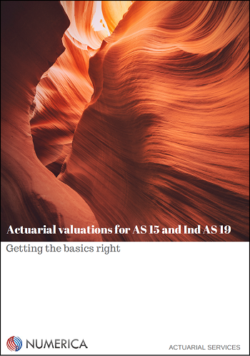
Under the right circumstances, a decision for funding a gratuity scheme could deliver significant benefits to the companies.
Gratuity is a statutory benefit – employers are required to pay a lumpsum benefit to their employees who have served for at least five years. The lumpsum is generally calculated as 15 days of eligible salary for each year of service.
Unlike certain other benefits like salaries, bonuses and life insurance, an employee receives gratuity only at the exit from the company and not while in service.
This post discusses the issues to consider on whether to fund a gratuity scheme. We have a separate post for schemes which are funded already, providing answer to some commonly asked questions. Another post, which can be accessed here, discusses various mis-conceptions about insurer-managed gratuity funds.
Funding and accounting
Companies need to recognise a liability in their financial statements in respect of the gratuity accrued to their employees. The liability is calculated by carrying out an actuarial valuation as per the provisions of AS 15 or Ind AS 19. Though a liability is recorded in the financial statements, currently companies are not required to set aside funds to back these liabilities. Therefore, many companies run ‘unfunded’ gratuity schemes where there are no backing assets. A scheme where funds have been set aside is referred to as a ‘funded’ scheme.
Companies can choose to set aside funds to back their gratuity liabilities. The current regulatory framework in India does not prescribe the amount of funds to be maintained and companies can choose to maintain a level of funding that they are comfortable with. Companies are also free to choose the amount of contributions they want to make into the fund. Actuarial liability assessed under AS 15 or Ind AS 19 is totally independent of the funding issues, such as solvency, target assets and contributions.
Issues to consider for funding a gratuity scheme
Deciding whether to fund gratuity liabilities is a long-term strategic decision and a multitude of issues need to be considered. In this post, we list down some important ‘generic’ issues, which would be applicable to most companies contemplating funding their gratuity schemes.
1. Tax benefits
From an employer’s perspective, there are three types of tax benefits on offer if gratuity scheme is funded:
- Annually, an amount equal to 8.33% of basic salaries can be paid into a gratuity fund as a tax-deductible expense.
- If the gratuity liabilities are funded for the first time, a contribution of 8.33% for each year of past service of an employee can be paid into the gratuity fund as a tax-deductible expense.
- Interest or investment income earned within the gratuity fund is also tax-free.
A carefully planned funding strategy can significantly reduce the tax bill of a company. However, tax benefits are not the only consideration for deciding whether to fund a gratuity scheme.
2. Opportunity cost
For funding gratuity liabilities, companies will need to find cash from within the business and commit to a gratuity trust. Arguably, the most important consideration would be the alternative ways that cash could be put to use and the return that cash would generate and for how long.
When making such a comparison, one thing to remember is that since the interest earned within a gratuity fund is tax-free. Therefore, an expected return of 10% pa is equivalent to 14% pa pre-tax return, after grossing up for tax at 30%.
An example – if a company can invest excess cash into a project that could generate a return of 20% pa for the shareholders consitently for several years and the expected return in gratuity fund is 10% pa (14% pre-tax), then using that cash for gratuity scheme funding would not seem to be an attractive proposition. If the cash is just generating interest income at the bank rate, say 5%, then it would be better off backing gratuity.
Excess cash can be returned back to shareholders as dividends, but this option will generally be less attractive than funding, given the tax benefits.
3. Liquidity management
If liabilities are unfunded, companies will need to pay off the gratuities to leaving employees as and when they leave. Therefore, the amount companies would pay could vary greatly from year to year as the number of people leaving will be uncertain. This would be a particular concern for small or mid-size companies where the resignation of just a few senior employees, with high salary and service, could create a strain on their cashflow positions. On the other hand, if a scheme is ‘scientifically’ (or actuarially) funded, the fund will build up during the years when no major payouts are paid and then used when large payoffs are required to be paid.
4. Cashflow stability
For new companies, the gratuity payments to employees would be few and low. However, gratuity payouts increase nearly exponentially as employees age and work longer. By having the liabilities funded, companies can replace the rapidly increasingly gratuity payouts with a relatively stable stream of contributions into the fund.
5. Cost management
Once funds are set aside to back the gratuity liabilities, a thoughtful investment strategy could go a long way in enhancing the returns and therefore reducing the costs for the employer. Although there is no single strategy that would suit all companies, there are a few things to consider:
- Companies can save on investment management expenses by managing the assets in house. This is suitable for large companies who can afford to set up an investment management team in-house.
- Small and medium sized companies would be better off by having a third party asset manager (such as an insurance company) to manage the funds. This strategy would also help in companies get access to asset classes which they may not be allowed to invest in if managing the fund in-house (e.g. equities).
Conclusion
Ultimately, the decision to fund will depend on how important the above factors are for the company, for meeting their overall business objectives. Generally, new companies often overlook this issue as there are other more pressing issues to consider. However, even for small and new companies, there is a lot to gain from better liquidity and stability. Larger companies will have a lot to gain from the tax benefits on offer.
Download our guide on the basics of actuarial valuation by clicking on the picture below:


December 21, 2018 at 11:20 am, Nitin Bhavsar said:
Can a newly setup Gratuity trust, fund the entire 100% of actuarial liability in lumpsum. Will the gratuity trust get taxation benefit to the extent 100% of funded amount, which may exceed 8.33% of annual basic salary.